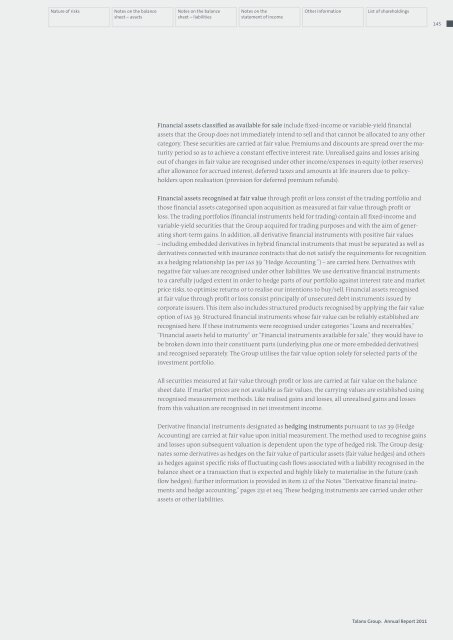talanx group annual report 2011 en
talanx group annual report 2011 en
talanx group annual report 2011 en
Create successful ePaper yourself
Turn your PDF publications into a flip-book with our unique Google optimized e-Paper software.
Nature of risks Notes on the balance<br />
sheet – assets<br />
Notes on the balance<br />
sheet – liabilities<br />
Notes on the<br />
statem<strong>en</strong>t of income<br />
Other information List of shareholdings<br />
Financial assets classified as available for sale include fixed-income or variable-yield financial<br />
assets that the Group does not immediately int<strong>en</strong>d to sell and that cannot be allocated to any other<br />
category. These securities are carried at fair value. Premiums and discounts are spread over the maturity<br />
period so as to achieve a constant effective interest rate. Unrealised gains and losses arising<br />
out of changes in fair value are recognised under other income/exp<strong>en</strong>ses in equity (other reserves)<br />
after allowance for accrued interest, deferred taxes and amounts at life insurers due to policyholders<br />
upon realisation (provision for deferred premium refunds).<br />
Financial assets recognised at fair value through profit or loss consist of the trading portfolio and<br />
those financial assets categorised upon acquisition as measured at fair value through profit or<br />
loss. The trading portfolios (financial instrum<strong>en</strong>ts held for trading) contain all fixed-income and<br />
variable-yield securities that the Group acquired for trading purposes and with the aim of g<strong>en</strong>erating<br />
short-term gains. In addition, all derivative financial instrum<strong>en</strong>ts with positive fair values<br />
– including embedded derivatives in hybrid financial instrum<strong>en</strong>ts that must be separated as well as<br />
derivatives connected with insurance contracts that do not satisfy the requirem<strong>en</strong>ts for recognition<br />
as a hedging relationship (as per IAS 39 “Hedge Accounting ”) – are carried here. Derivatives with<br />
negative fair values are recognised under other liabilities. We use derivative financial instrum<strong>en</strong>ts<br />
to a carefully judged ext<strong>en</strong>t in order to hedge parts of our portfolio against interest rate and market<br />
price risks, to optimise returns or to realise our int<strong>en</strong>tions to buy/sell. Financial assets recognised<br />
at fair value through profit or loss consist principally of unsecured debt instrum<strong>en</strong>ts issued by<br />
corporate issuers. This item also includes structured products recognised by applying the fair value<br />
option of IAS 39. Structured financial instrum<strong>en</strong>ts whose fair value can be reliably established are<br />
recognised here. If these instrum<strong>en</strong>ts were recognised under categories “Loans and receivables,”<br />
“Financial assets held to maturity” or “Financial instrum<strong>en</strong>ts available for sale,” they would have to<br />
be brok<strong>en</strong> down into their constitu<strong>en</strong>t parts (underlying plus one or more embedded derivatives)<br />
and recognised separately. The Group utilises the fair value option solely for selected parts of the<br />
investm<strong>en</strong>t portfolio.<br />
All securities measured at fair value through profit or loss are carried at fair value on the balance<br />
sheet date. If market prices are not available as fair values, the carrying values are established using<br />
recognised measurem<strong>en</strong>t methods. Like realised gains and losses, all unrealised gains and losses<br />
from this valuation are recognised in net investm<strong>en</strong>t income.<br />
Derivative financial instrum<strong>en</strong>ts designated as hedging instrum<strong>en</strong>ts pursuant to IAS 39 (Hedge<br />
Accounting) are carried at fair value upon initial measurem<strong>en</strong>t. The method used to recognise gains<br />
and losses upon subsequ<strong>en</strong>t valuation is dep<strong>en</strong>d<strong>en</strong>t upon the type of hedged risk. The Group designates<br />
some derivatives as hedges on the fair value of particular assets (fair value hedges) and others<br />
as hedges against specific risks of fluctuating cash flows associated with a liability recognised in the<br />
balance sheet or a transaction that is expected and highly likely to materialise in the future (cash<br />
flow hedges); further information is provided in item 12 of the Notes “Derivative financial instrum<strong>en</strong>ts<br />
and hedge accounting,” pages 231 et seq. These hedging instrum<strong>en</strong>ts are carried under other<br />
assets or other liabilities.<br />
Talanx Group. Annual Report <strong>2011</strong><br />
145
















